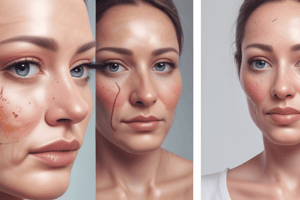Podcast
Questions and Answers
What is the risk of infection in Class I wounds?
What is the risk of infection in Class I wounds?
- 20-30%
- 3-6%
- 4-20%
- 1-4% (correct)
What type of wounds carry a slightly higher risk of infection?
What type of wounds carry a slightly higher risk of infection?
- Class II wounds (correct)
- Wounds with prosthetic material
- Class III wounds
- Class I wounds
What is the purpose of wound classification systems?
What is the purpose of wound classification systems?
- To predict the outcome of the procedure
- To determine the type of anesthesia to use
- To decide whether to administer prophylactic antibiotics (correct)
- To select the type of surgical instruments
What type of wounds have a substantial risk of infection?
What type of wounds have a substantial risk of infection?
What is a characteristic of Class I wounds?
What is a characteristic of Class I wounds?
What is the purpose of a series of maneuvers in wound care?
What is the purpose of a series of maneuvers in wound care?
Flashcards are hidden until you start studying
Study Notes
Wound Classification
- Class I wounds: only skin microflora may contaminate the operative field, with a low risk of infection (1-4%).
- Class I wounds may include prosthetic material, such as mesh or a cardiac valve, and the consequences of wound infection can be severe.
Clean Contaminated Wounds
- Class II clean contaminated wounds: a hollow viscus with resident microbes is entered, resulting in a higher risk of infection (3-6%).
- Both skin microflora and resident microbes may be present in the wound.
Contaminated Wounds
- Class III wounds: substantial microbial contamination is present (e.g., fecal soilage; traumatic heavily contaminated wound), with a higher risk of infection (4-20%).
- The risk of infection is particularly high if the skin edges of the superficial wound are opposed.
Wound Infection Prevention
- Preoperative patient skin preparation: scrubbing the prospective wound area and showering with a topical microbicide.
- Hair clipping, but avoidance of shaving the skin of the prospective wound site, to prevent microbial proliferation in areas of epidermal damage.
- Surgeon hand scrubbing and patient skin preparation with a topical microbicide immediately before the procedure.
- Instrument sterilization and avoidance of breaks in aseptic technique.
- Use of mechanical preparation, intraluminal antibiotics, or antiseptics for selected procedures to reduce the microbial inoculum within a hollow viscus.
Studying That Suits You
Use AI to generate personalized quizzes and flashcards to suit your learning preferences.



